 W
WThe 4 ft 6 in track gauge, also called the Scotch gauge, was adopted by early 19th century railways mainly in the Lanarkshire area of Scotland. It differed from the gauge of 4 ft 8 in that was used on some early lines in England. Early railways chose their own gauge, but later in the century interchange of equipment was facilitated by establishing a uniform rail gauge across railways: a so-called 'standard gauge' of 4 ft 8 1⁄2 in. In the early 1840s standard gauge lines began to be constructed in Scotland, and all the Scotch gauge lines were eventually converted to standard gauge. The gauge was outlawed in Great Britain in 1846. From 1903, tram lines of Tokyo adopted this gauge.
 W
WThe Anti-Burghers were opponents of the Burgher Oath on theological grounds.
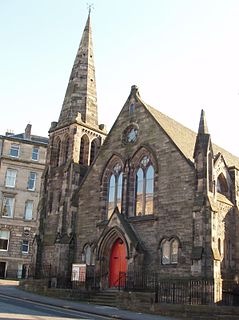 W
WBellevue Chapel is a church in Rodney Street in Canonmills, Edinburgh, Scotland.
 W
WSt Mary's College, Blairs, situated near Aberdeen in Scotland, was from 1829 to 1986 a junior seminary for boys and young men studying for the Roman Catholic priesthood. Part of the former college now houses Blairs Museum, the museum of Scotland's Catholic heritage. The New Chapel is a Category A listed building, with the other buildings listed as Category B.
 W
WDuring the Enlightenment and the industrial revolution, Scottish industrial policy was made by the Board of Trustees for Fisheries, Manufactures and Improvements in Scotland, which sought to build an economy complementary, not competitive, with England. Since England had woollens, this meant linen.
 W
WBute House is the official residence of the First Minister of Scotland located within Charlotte Square in Edinburgh, the capital city of Scotland. Alongside two other offices at Holyrood and St. Andrew's House, Bute House also has a smaller office used by the First Minister when in official residence.
 W
WThe Cardross Case was a 19th century court case in Cardross in Scotland involving the Parish of Cardross and The Free Church of Scotland. It tested the limits between ecclesiastical and secular courts. The 19th century was an eventful period for Scottish religion and this case in many ways reverberated echoes from the Disruption of 1843. The case was reported on in media overseas, both in America and Australia.
 W
WThe Clyde puffer is a type of small coal-fired and single-masted cargo ship, built mainly on the Forth and Clyde canal, and which provided a vital supply link around the west coast and Hebrides of Scotland.
 W
WThe Court of Exchequer was formerly a distinct part of the court system of Scotland, with responsibility for administration of government revenue and jurisdiction of adjudicate on cases relating to customs and excise, revenue, stamp duty and probate. In 1856 the Court of Session was designated as the Exchequer Court, which now carries out its judicial functions.
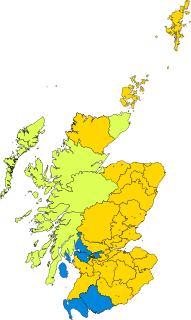 W
WThe Crofters' Party was the parliamentary arm of the Highland Land League. It managed to elect five MPs in the 1885 general election and a sixth the following year.
 W
WThe Democratic Intellect: Scotland and her Universities in the Nineteenth Century is a 1961 book by philosopher George Elder Davie.
 W
WThe Church of St John the Evangelist is a Scottish Episcopal church in the centre of Edinburgh, Scotland. It is sited at the west end of Princes Street at its junction with Lothian Road, and is protected as a category A listed building.
 W
WScottish education in the nineteenth century concerns all forms of education, including schools, universities and informal instruction, in Scotland in the nineteenth century. By the late seventeenth century there was a largely complete system of parish schools, but it was undermined by the Industrial Revolution and rapid urbanisation. The Church of Scotland, the Free Church of Scotland and the Catholic church embarked on programmes of school building to fill in the gaps in provision, creating a fragmented system. Attempts to supplement the parish system included Sunday schools, mission schools, ragged schools, Bible societies and improvement classes. Scots played a major part in the development of teacher education with figures including William Watson, Thomas Guthrie, Andrew Bell, John Wood and David Stow. Scottish schoolmasters gained a reputation for strictness and frequent use of the tawse. The perceived problems and fragmentation of the Scottish school system led to a process of secularisation, as the state took increasing control. The Education (Scotland) Act 1872 transferred the Kirk and Free Kirk schools to regional School Boards and made some provision for secondary education. In 1890 school fees were abolished, creating a state-funded, national system of compulsory free basic education with common examinations.
 W
WThe Eglinton Tournament Bridge is a bridge located within Eglinton Country Park near Kilwinning, North Ayrshire, Scotland. The bridge crosses the Lugton Water a short distance northwest of Eglinton Castle and was named after the Eglinton Tournament of 1839. The castle and surrounding grounds were once home to the Montgomerie family, Earls of Eglinton and chiefs of the Clan Montgomery.
 W
WThe City Chambers or Municipal Buildings in Glasgow, Scotland, has functioned as the headquarters of Glasgow City Council since 1996, and of preceding forms of municipal government in the city since 1889. It is located on the eastern side of the city's George Square. It is a Category A listed building.
 W
WThe voco Grand Central Glasgow is a large 4-star hotel in the centre of Glasgow, Scotland.
 W
WThe West Kirk is a Church of Scotland parish church on Colquhoun Square in Helensburgh, Argyll, Scotland. Designed by James Hay, in 1853, it is designated as a Category B listed building by Historic Environment Scotland.
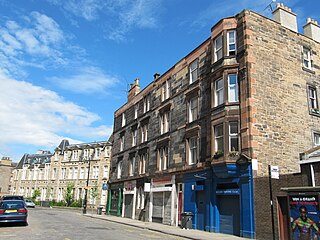 W
WHenderson Street is a street in Leith, a district of the city of Edinburgh, Scotland. It forms a curving artery between Great Junction Street and an area known as the Shore, where the Water of Leith runs into the Port of Leith/Leith Docks. Henderson Street lies within the boundaries of the Leith Conservation Area and includes several listed buildings.
 W
WThe Highland Clearances were the evictions of a significant number of tenants in the Scottish Highlands and Islands, mostly in the period 1750 to 1860.
 W
WThe first Highland Land League emerged as a distinct political force in Scotland during the 1880s, with its power base in the country's Highlands and Islands. It was known also as the Highland Land Law Reform Association and the Crofters' Party. It was consciously modelled on the Irish Land League.
 W
WThe Hub is a public arts and events building in the centre of Edinburgh, Scotland. Located at the top of the Royal Mile, it is a prominent landmark as its tall gothic spire is the highest point in central Edinburgh, and towers over the surrounding buildings below Edinburgh Castle.
 W
WThe Laigh Kirk is a church in Kilmarnock, East Ayrshire, Scotland.
 W
WThe Lowland Clearances were one of the results of the Scottish Agricultural Revolution, which changed the traditional system of agriculture which had existed in Lowland Scotland in the seventeenth century. Thousands of cottars and tenant farmers from the southern counties (Lowlands) of Scotland migrated from farms and small holdings they had occupied to the new industrial centres of Glasgow, Edinburgh and northern England or abroad, or remaining upon land though adapting to the Scottish Agricultural Revolution.
 W
WMusic of Scotland in the nineteenth century includes all forms of music production in the period, in Scotland or by Scottish people.
 W
WIn philosophy of perception and philosophy of mind, naïve realism is the idea that the senses provide us with direct awareness of objects as they really are. When referred to as direct realism, naïve realism is often contrasted with indirect realism.
 W
WThe Office of the Accountant of Court is a public body which is a constituent part of the Supreme Courts of Scotland. The Accountant of Court is administered by the Scottish Courts and Tribunals Service.
 W
WOrion was a G & J Burns paddle steamer, built by Caird & Co in 1847, which struck a submerged rock and sank off Portpatrick Lighthouse, Wigtownshire, Scotland, on 18 June 1850 on her way from Liverpool to Glasgow, with the loss of 41 of the 200 passengers on board. The eminent surgeon John Burns was one of the passengers killed in the accident. Some of the survivors were rescued by the Isle of Man vessel Fenella, others by boats from Portpatrick.
 W
WThe Plinian Society was a club at the University of Edinburgh for students interested in natural history. It was founded in 1823. Several of its members went on to have prominent careers, most notably Charles Darwin who announced his first scientific discoveries at the society.
 W
WQueen Margaret University, Edinburgh is a public university, founded in 1875 and located in Musselburgh, Scotland. It is named after Saint Margaret, wife of King Malcolm III of Scotland. Its predecessor, Queen Margaret University College, was awarded full university status becoming Queen Margaret University, Edinburgh in January 2007.
 W
WRomanticism in Scotland was an artistic, literary and intellectual movement that developed between the late eighteenth and the early nineteenth centuries. It was part of the wider European Romantic movement, which was partly a reaction against the Age of Enlightenment, emphasising individual, national and emotional responses, moving beyond Renaissance and Classicist models, particularly to the Middle Ages.
 W
WThe Royal Arch or Victoria Arch was a structure erected in Dundee, Scotland, between 1849 and 1853 and demolished in 1964. The monumental archway formerly stood over the access to the pier between Earl Grey Dock and King William IV Dock on the city's waterfront.
 W
WThe Royal Scottish Forestry Society was founded in 1854 as the Scottish Arboricultural Society. In 1869, the society received the patronage of Queen Victoria and the "Royal" prefix was added in 1887. The name changed to the current one in 1930.
 W
WSaint Ternan's Church is an Episcopal church in the Diocese of Brechin, near Muchalls in Aberdeenshire, Scotland.
 W
WThe Scotsman is a Scottish compact newspaper and daily news website headquartered in Edinburgh. First established as a radical political paper in 1817, it began daily publication in 1855 and remained a broadsheet until August 2004. Its parent company, JPIMedia, also publishes the Edinburgh Evening News. It had an audited print circulation of 16,349 for July to December 2018. Its website, Scotsman.com, had an average of 138,000 unique visitors a day as of 2017. The title celebrated its bicentenary on 25 January 2017.
 W
WScottish art in the nineteenth century is the body of visual art made in Scotland, by Scots, or about Scottish subjects. This period saw the increasing professionalisation and organisation of art in Scotland. Major institutions founded in this period included the Institution for the Encouragement of the Fine Arts in Scotland, the Royal Scottish Academy of Art, the National Gallery of Scotland, the Scottish National Portrait Gallery and the Glasgow Institute. Art education in Edinburgh focused on the Trustees Drawing Academy of Edinburgh. Glasgow School of Art was founded in 1845 and Grays School of Art in Aberdeen in 1885.
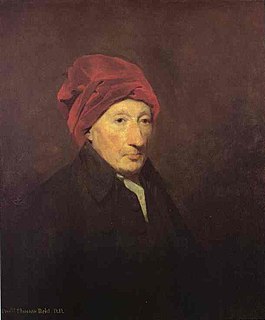 W
WScottish common sense realism, also known as the Scottish school of common sense, is a realist school of philosophy that originated in the ideas of Scottish philosophers Thomas Reid, Adam Ferguson, James Beattie, and Dugald Stewart during the 18th-century Scottish Enlightenment. Reid emphasized man's innate ability to perceive common ideas and that this process is inherent in and interdependent with judgement. Common sense, therefore, is the foundation of philosophical inquiry. Though best remembered for its opposition to the pervasive philosophy of David Hume, Scottish common sense philosophy is influential and evident in the works of Thomas Jefferson and late 18th-century American politics.
 W
WThe Scottish Liberal Party, the section of the Liberal Party in Scotland, was the dominant political party of Victorian Scotland, and although its importance declined with the rise of the Labour and Unionist parties during the 20th century, it was still a significant, albeit much reduced force when it finally merged with the Social Democratic Party in Scotland, to form the Scottish Liberal Democrats in 1988.
 W
WScottish literature in the nineteenth century includes all written and published works in Scotland or by Scottish writers in the period. It includes literature written in English, Scottish Gaelic and Scots in forms including poetry, novels, drama and the short story.
 W
WScottish religion in the nineteenth century includes all forms of religious organisation and belief in Scotland in the 19th century. This period saw a reaction to the population growth and urbanisation of the Industrial Revolution that had undermined traditional parochial structures and religious loyalties. The established Church of Scotland reacted with a programme of church building from the 1820s. Beginning in 1834 the "Ten Years' Conflict" ended in a schism from the established Church of Scotland led by Dr Thomas Chalmers known as the Great Disruption of 1843. Roughly a third of the clergy, mainly from the North and Highlands, formed the separate Free Church of Scotland. The evangelical Free Church and other secessionist churches grew rapidly in the Highlands and Islands and urban centres. There were further schisms and divisions, particularly between those who attempted to maintain the principles of Calvinism and those that took a more personal and flexible view of salvation. However, there were also mergers that cumulated in the creation of a United Free Church in 1900 that incorporated most of the secessionist churches.
 W
WThe Scottish Rugby Union is the governing body of rugby union in Scotland. It is the second oldest Rugby Union, having been founded in 1873, as the Scottish Football Union. The SRU oversees the national league system, known as the Scottish League Championship, and the Scottish National teams. The SRU is headed by the President and Chairman, with Mark Dodson acting as the Chief Executive Officer. Bradbury became the first female president of a Tier 1 rugby nation upon her appointment on 4 August 2018.
 W
WThomas Telford FRS, FRSE was a Scottish civil engineer, architect and stonemason, and road, bridge and canal builder. After establishing himself as an engineer of road and canal projects in Shropshire, he designed numerous infrastructure projects in his native Scotland, as well as harbours and tunnels. Such was his reputation as a prolific designer of highways and related bridges, he was dubbed The Colossus of Roads, and, reflecting his command of all types of civil engineering in the early 19th century, he was elected as the first President of the Institution of Civil Engineers, a post he held for 14 years until his death.
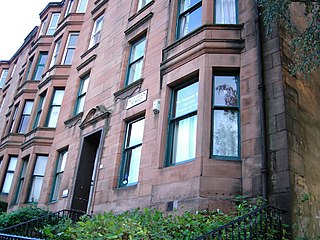 W
WThe Tenement House is a historic house museum in Glasgow, owned and operated by the National Trust for Scotland.
 W
WWeir of Hermiston (1896) is an unfinished novel by Robert Louis Stevenson. It is markedly different from his previous works in style and has often been praised as a potential masterpiece. It was cut short by Stevenson's sudden death in 1894 from a cerebral haemorrhage. The novel is set at the time of the Napoleonic Wars.